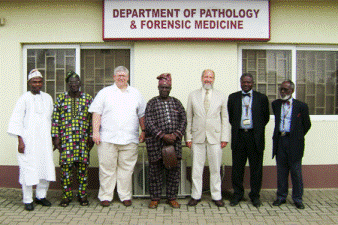Natural Resources, School of

Karl Reinhard Publications
Document Type
Article
Date of this Version
1998
Citation
Published in MUMMIES, DISEASE & ANCIENT CULTURES, Second Edition, ed. Aidan Cockburn, Eve Cockburn, and Theodore A. Reyman. Cambridge: Cambridge University Press, 1998. pp. 353–394.
Abstract
In this chapter, we shall see how the amplification of minute amounts of genetic material by the polymerase chain reaction (PCR) has enabled researchers to identifY both native and infectious DNA in these bodies. The use of amplified bacterial and viral DNA may turn out to be Aidan Cockburn's 'magic bullet' for solving some of the mysteries of infectious disorders in ancient populations. In the same fashion, native DNA may give us clues to a variety of genetic abnormalities that existed in those distant times. These newer techniques will be the focus of the revised technical section in this second edition. The standardized chemical, histological, radiographic and serologic techniques can be reviewed in the technical section of the first edition or in other references from the scientific literature. These new test methods do not replace the older ones, but complement them. Both are necessary. The future will provide other methods, introduced by the ingenuity of our scientific colleagues in many disciplines. Only time will tell how many. ...
The study of ancient diet, paleonutrition, is a field of intense interest among archaeologists. Three goals of paleo nutrition defined by Armelagos (I994) are the range of foods available (general menu), which foods were eaten (diet), and whether or not the diet was physiologically sound (nutrition). Techniques have developed for the study of dietary residues from archaeological sites such as feces, pollen, animal bone, seeds, mollusk shell, and so on. (Gilbert and Mielke I985). In addition, bioarchaeologists have developed a wide array of techniques to identify dietary signals in human bone and hair, including stable isotopes of nitrogen and carbon and also by trace elemental analysis, usually barium and strontium (Labert and Grupe I993; Sandford I993). They also examine bone for pathological and developmental indicators of dietary sufficiency. All of these techniques can be transferred directly to the study of mummies. Mummies have an extremely important role in diet studies. The tombs often contain food offerings that provide an idea of the 'menu' of ancient cultures and the ritual/social importance of different foods. Analyses of intestinal contents (coprolites) reveal exactly what foods and medicines were eaten immediately before death. Trace elemental and stable isotopic analyses provide a general idea of the diet during life. Comparative isotopic ratios between soft tissue and bone indicate whether or not starvation was a problem immediately before death. Pathological indicators of stress can be found in the skeletons of mummies. They and their burials provide for a detailed reconstruction of ancient diet.


Comments
Copyright © 1998 Cambridge University Press. Used by permission.